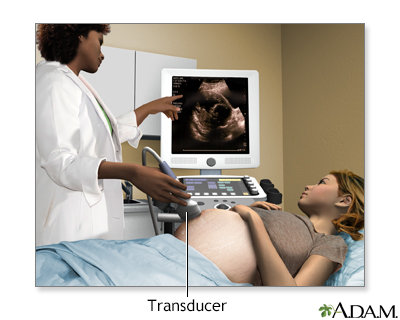Pregnancy SmartSiteTM
Tubal pregnancy; Cervical pregnancy; Tubal ligation - ectopic pregnancy DefinitionAn ectopic pregnancy is a pregnancy that occurs outside the womb (uterus). CausesIn most pregnancies, the fertilized egg travels through the fallopian tube to the womb (uterus). If the movement of the egg is blocked or slowed through the tubes, it can lead to an ectopic pregnancy. Things that may cause this problem include:
The following also increase risk for an ectopic pregnancy:
Sometimes, the cause is not known. Hormones may play a role. The most common site for an ectopic pregnancy is the fallopian tube. In rare cases, this can occur in the ovary, abdomen, or cervix. An ectopic pregnancy can occur even if you use birth control. SymptomsSymptoms of ectopic pregnancy may include:
If the area around the abnormal pregnancy ruptures and bleeds, symptoms may get worse. They may include:
Exams and TestsThe health care provider will do a pelvic exam. The exam may show tenderness in the pelvic area. A pregnancy test and vaginal ultrasound will be done. Human chorionic gonadotropin (hCG) is a hormone that is produced during pregnancy. Checking the blood level of this hormone can detect pregnancy.
You may need more than one exam, ultrasound, and blood test. Your provider will instruct you about signs to watch for until your next visit. TreatmentEctopic pregnancy may be life threatening. The pregnancy cannot continue to birth (term). Effective treatment requires either medical treatment to end the pregnancy or surgical removal of the pregnancy. If the ectopic pregnancy has not ruptured, treatment may include:
You will need emergency medical help if the area of the ectopic pregnancy breaks open (ruptures). Rupture can lead to bleeding and shock. Treatment for shock may include:
If there is a rupture, surgery is done to stop blood loss and remove the pregnancy. In some cases, the surgeon may have to remove the fallopian tube. Outlook (Prognosis)If diagnosed early, treatment is very effective. It's important to seek early care whenever you believe you may be pregnant so your provider may determine the location of the pregnancy. One out of three women who have had one ectopic pregnancy can have a baby in the future. Another ectopic pregnancy is more likely to occur. Some women do not become pregnant again. The likelihood of a successful pregnancy after an ectopic pregnancy depends on:
When to Contact a Medical ProfessionalContact your provider if you have:
PreventionMost forms of ectopic pregnancy that occur outside the fallopian tubes are probably not preventable. You may be able to reduce your risk by avoiding conditions that may scar the fallopian tubes. These steps include:
ReferencesAlur-Gupta S, Cooney LG, Senapati S, Sammel MD, Barnhart KT. Two-dose versus single-dose methotrexate for treatment of ectopic pregnancy: a meta-analysis. Am J Obstet Gynecol. 2019;221(2):95-108.e2. PMID: 30629908 pubmed.ncbi.nlm.nih.gov/30629908/. Henn MC, Lall MD. Complications of pregnancy. In: Walls RM, eds. Rosen's Emergency Medicine: Concepts and Clinical Practice. 8th ed. Philadelphia, PA: Elsevier; 2023:chap 173. Hur HC, Lobo RA. Ectopic pregnancy: etiology, pathology, diagnosis, management, fertility prognosis. In: Gershenson DM, Lentz GM, Valea FA, Lobo RA, eds. Comprehensive Gynecology. 8th ed. Philadelphia, PA: Elsevier; 2022:chap 17. Nelson AL, Gambone JC. Ectopic pregnancy. In: Hacker NF, Gambone JC, Hobel CJ, eds. Hacker & Moore's Essentials of Obstetrics and Gynecology. 6th ed. Philadelphia, PA: Elsevier; 2016:chap 24. | |
| |
Review Date: 3/31/2024 Reviewed By: LaQuita Martinez, MD, Department of Obstetrics and Gynecology, Emory Johns Creek Hospital, Alpharetta, GA. Also reviewed by David C. Dugdale, MD, Medical Director, Brenda Conaway, Editorial Director, and the A.D.A.M. Editorial team. The information provided herein should not be used during any medical emergency or for the diagnosis or treatment of any medical condition. A licensed medical professional should be consulted for diagnosis and treatment of any and all medical conditions. Links to other sites are provided for information only -- they do not constitute endorsements of those other sites. No warranty of any kind, either expressed or implied, is made as to the accuracy, reliability, timeliness, or correctness of any translations made by a third-party service of the information provided herein into any other language. © 1997- A.D.A.M., a business unit of Ebix, Inc. Any duplication or distribution of the information contained herein is strictly prohibited. | |

 Pelvic laparoscopy
Pelvic laparoscopy Ultrasound in preg...
Ultrasound in preg... Female reproductiv...
Female reproductiv... Uterus
Uterus Ectopic pregnancy
Ectopic pregnancy
